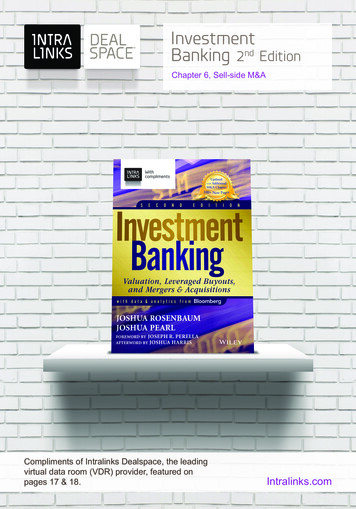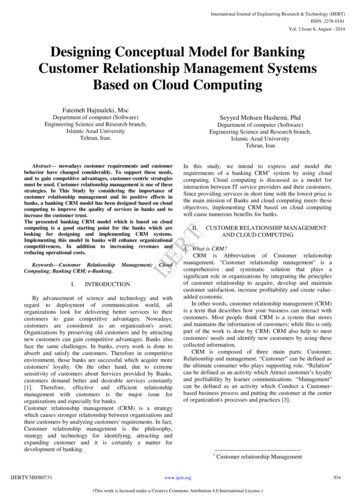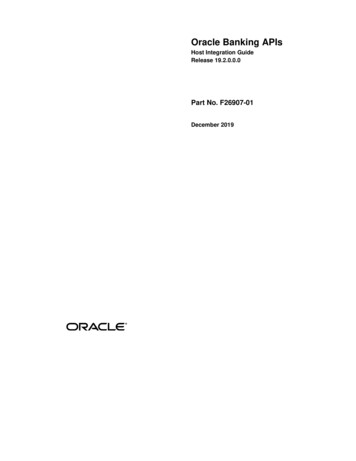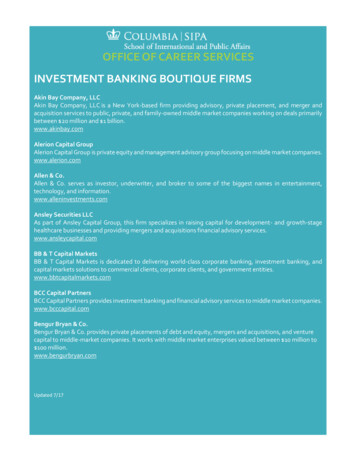
Transcription
InvestmentBanking 2nd EditionChapter 6, Sell-side M&ACompliments of Intralinks Dealspace, the leadingvirtual data room (VDR) provider, featured onpages 17 & 18.Intralinks.com
Letter from IntralinksDear Reader and M&A enthusiast,Thanks for downloading chapter six of Investment Banking, “Sell-side M&A”.We trust you’ll enjoy it!This chapter is compliments of Intralinks Dealspace, the leading virtual data roomprovider.If you enjoy learning about the intricacies of selling a business in this chapter, be sureto check out the entire second edition of Investment Banking and get more insight intoachieving success in the high stakes world of Wall Street.Here’s to your next successful M&A deal!Warmest regards,Matt PorzioVP of Strategy and Product MarketingIntralinks2
CHAPTER6Sell-Side M&AThe sale of a company, division, business, or collection of assets (“target”) is a majorevent for its owners (shareholders), management, employees, and other stakeholders. It is an intense, time-consuming process with high stakes, usually spanning severalmonths. Consequently, the seller typically hires an investment bank and its team oftrained professionals (“sell-side advisor”) to ensure that key objectives are met and afavorable result is achieved. In many cases, a seller turns to its bankers for a comprehensive financial analysis of the various strategic alternatives available to the target.These include a sale of all or part of the business, a recapitalization, an initial publicoffering, or a continuation of the status quo.Once the decision to sell has been made, the sell-side advisor seeks to achieve theoptimal mix of value maximization, speed of execution, and certainty of completionamong other deal-specific considerations for the selling party. Accordingly, it is the sellside advisor’s responsibility to identify the seller’s priorities from the onset and craft atailored sale process. If the seller is largely indifferent toward confidentiality, timing, andpotential business disruption, the advisor may consider running a broad auction reachingout to as many potential interested parties as reasonably possible. This process, which isrelatively neutral toward prospective buyers, is designed to maximize competitive dynamics and heighten the probability of finding the one buyer willing to offer the best value.Alternatively, if speed, confidentiality, a particular transaction structure, and/orcultural fit are a priority for the seller, then a targeted auction, where only a selectgroup of potential buyers are approached, or even a negotiated sale with a single party,may be more appropriate. Generally, an auction requires more upfront organization,marketing, process points, and resources than a negotiated sale with a single party.Consequently, this chapter focuses primarily on the auction process.From an analytical perspective, a sell-side assignment requires the deal team toperform a comprehensive valuation of the target using those methodologies discussedin this book. In addition, in order to assess the potential purchase price that specificpublic strategic buyers may be willing to pay for the target, merger consequences analysisis performed with an emphasis on accretion/(dilution) and balance sheet effects (seeChapter 7). These valuation analyses are used to frame the seller’s price expectations,select the final buyer list, set guidelines for the range of acceptable bids, evaluate offersreceived, and ultimately guide negotiations of the final purchase price. Furthermore, forpublic targets (and certain private targets, depending on the situation) the sell-side advisor or an additional investment bank may be called upon to provide a fairness opinion.3
4 MERGERS & ACQUISITIONSIn discussing the process by which companies are bought and sold in themarketplace, we provide greater context to the topics discussed earlier in this book.In a sale process, theoretical valuation methodologies are ultimately tested in themarket based on what a buyer will actually pay for the target (see Exhibit 6.1). Aneffective sell-side advisor seeks to push the buyer(s) toward, or through, the upperendpoint of the implied valuation range for the target. On a fundamental level, thisinvolves properly positioning the business and tailoring the sale process accordinglyto maximize its value.AUCTIONSAn auction is a staged process whereby a target is marketed to multiple prospectivebuyers (“buyers” or “bidders”). A well-run auction is designed to have a substantialpositive impact on value (both price and terms) received by the seller due to a varietyof factors related to the creation of a competitive environment. This environmentencourages bidders to put forth their best offer on both price and terms, and helpsincrease speed of execution by encouraging quick action by buyers.An auction provides a level of comfort that the market has been tested as well asa strong indicator of inherent value (supported by a fairness opinion, if required). Atthe same time, the auction process may have potential drawbacks, including information leakage into the market from bidders, negative impact on employee morale,possible collusion among bidders, reduced negotiating leverage once a “winner” ischosen (thereby encouraging re-trading1), and “taint” in the event of a failed auction.In addition, certain prospective buyers may decide not to participate in a broad auction given their reluctance to commit serious time and resources to a situation wherethey may perceive a relatively low likelihood of winning.A successful auction requires significant dedicated resources, experience, andexpertise. Upfront, the deal team establishes a solid foundation through the preparation of compelling marketing materials, identification of potential deal issues, coachingof management, and selection of an appropriate group of prospective buyers. Oncethe auction commences, the sell-side advisor is entrusted with running as effective aprocess as possible. This involves the execution of a wide range of duties and functions in a tightly coordinated manner.To ensure a successful outcome, investment banks commit a team of bankersthat is responsible for the day-to-day execution of the transaction. Auctions alsorequire significant time and attention from key members of the target’s managementteam, especially on the production of marketing materials and facilitation of buyerdue diligence (e.g., management presentations, site visits, data room population, andresponses to specific buyer inquiries). It is the deal team’s responsibility, however, toalleviate as much of this burden from the management team as possible.In the later stages of an auction, a senior member of the sell-side advisory teamtypically negotiates directly with prospective buyers with the goal of encouraging themto put forth their best offer. As a result, sellers seek investment banks with extensivenegotiation experience, sector expertise, and buyer relationships to run these auctions.Refers to the practice of replacing an initial bid with a lower one at a later date.1
5PrecedentTransactions AnalysisValuation based on themultiples paid for peercompanies in past M&AtransactionsM&A market conditionsDeal specific situationPremium paid for controlLevel of synergiesValuation based on thecurrent trading multiplesof peer companiesRelative performance topeer companiesLeveragedBuyout AnalysisValuation based on theprice a financial sponsorwould likely payFree cash flowCost of capitalTerminal valueCredit market conditionsFree cash flowAbility to leverageDebt repaymentCost of capitalRequired returnsUnique Value DriversSector performance and outlookCompany performance- size, margins and growth profile- historical and projected financial performanceCompany positioning- market share- ability to differentiate products/services- quality of managementGeneral economic and financing market conditionsCommon Value DriversValuation based on thepresent value of projectedfree cash flowDescriptionDiscountedCash Flow AnalysisImplied Valuation RangeValuation ParadigmComparableCompanies AnalysisEXHIBIT 6.1Process dynamics- auction vs. negotiated sale- number of parties in process- level of information disclosure- “trophy”/must own assetBuyer appetite- strategic vs. sponsor- desire/ability to pay- amount needed to “win”Pro forma impact to buyer- financial effects- pro forma leverage- returns thresholdsDetermines the ultimate price abuyer is willing to payM&A Sale ProcessActual Price Paid
6 MERGERS & ACQUISITIONSThere are two primary types of auctions—broad and targeted. Broad Auction: As its name implies, a broad auction maximizes the universe ofprospective buyers approached. This may involve contacting dozens of potentialbidders, comprising both strategic buyers (potentially including direct competitors) and financial sponsors. By casting as wide a net as possible, a broad auctionis designed to maximize competitive dynamics, thereby increasing the likelihoodof finding the best possible offer. This type of process typically involves moreupfront organization and marketing due to the larger number of buyer participants in the early stages of the process. It is also more difficult to maintainconfidentiality as the process is susceptible to leakage to the public (includingcustomers, suppliers, and competitors), which, in turn, can increase the potentialfor business disruption.2Targeted Auction: A targeted auction focuses on a few clearly defined buyersthat have been identified as having a strong strategic fit and/or desire, as well asthe financial capacity, to purchase the target. This process is more conducive tomaintaining confidentiality and minimizing business disruption to the target. Atthe same time, there is greater risk of “leaving money on the table” by excludinga potential bidder that may be willing to pay a higher price.Exhibit 6.2 provides a summary of the potential advantages and disadvantagesof each process.EXHIBIT 6.2Advantages and Disadvantages of Broad and Targeted AuctionsBroadAdvantages Disadvantages Heightens competitive dynamicsMaximizes probability ofachieving maximum sale priceHelps to ensure that all likelybidders are approachedLimits potential buyers’negotiating leverageEnhances board’s comfort that ithas satisfied its fiduciary duty tomaximize valueDifficult to preserveconfidentialityHighest business disruption riskSome prospective buyers declineparticipation in broad auctionsUnsuccessful outcome can createperception of undesirable assetIndustry competitors mayparticipate just to gain access tosensitive informationTargeted Higher likelihood of preservingconfidentialityReduces business disruptionReduces the potential of a failedauction by signaling a desire toselect a “partner”Maintains perception ofcompetitive dynamicsServes as a “market check” forboard to meet its fiduciary dutiesPotentially excludes nonobvious, but credible, buyersPotential to leave “money on thetable” if certain buyers excludedLesser degree of competitionMay afford buyers moreleverage in negotiationsProvides less market data onwhich board can rely to satisfyits fiduciary dutiesIn some circumstances, the auction is actually made public by the seller to encourage allinterested buyers to come forward and state their interest in the target.2
Sell-Side M&A 7Auction StructureThe traditional auction is structured as a two-round bidding process that generallyspans from three to six months (or longer) from the decision to sell until the signingof a definitive purchase/sale agreement (“definitive agreement”) with the winningbidder (see Exhibit 6.3). The timing of the post-signing (“closing”) period dependson a variety of factors not specific to an auction, such as regulatory approvals and/orthird-party consents, financing, and shareholder approval. The entire auction processconsists of multiple stages and discrete milestones within each of these stages. Thereare numerous variations within this structure that allow the sell-side advisor to customize, as appropriate, for a given situation.ORGANIZATION AND PREPAR ATION Identify Seller Objectives and Determine Appropriate Sale Process Perform Sell-Side Advisor Due Diligence and Preliminary Valuation Analysis Select Buyer Universe Prepare Marketing Materials Prepare Confidentiality AgreementIdentify Seller Objectives and Determine Appropriate Sale ProcessAt the onset of an auction, the sell-side advisor works with the seller to identifyits objectives, determine the appropriate sale process to conduct, and develop aprocess roadmap. The advisor must first gain a clear understanding of the seller’spriorities so as to tailor the process accordingly. Perhaps the most basic decisionis how many prospective buyers to approach (i.e., whether to run a broad ortargeted auction).As previously discussed, while a broad auction may be more appealing toa seller in certain circumstances, a targeted auction may better satisfy certain“softer” needs, such as speed to transaction closing, heightened confidentiality, atailored transaction structure, and less risk of business disruption. Furthermore,the target’s board of directors must also take into account its fiduciary duties indeciding whether to conduct a broad or targeted auction.3 At this point, the dealteam drafts a detailed process timeline and roadmap, including target dates forsignificant milestones, such as launch, receipt of initial and final bids, contractsigning, and deal closing.In Delaware (which generally sets the standards upon which many states base their corporatelaw), when the sale of control or the break-up of a company has become inevitable, the directorshave the duty to obtain the highest price reasonably available. There is no statutory or judicial“blueprint” for an appropriate sale or auction process. Directors enjoy some latitude in thisregard, so long as the process is designed to satisfy the directors’ duties by ensuring that theyhave reasonably informed themselves about the company’s value.3
8 2 – 4 weeksIdentify sellerobjectives anddetermine appropriatesale processPerform sell-sideadvisor due diligenceand preliminaryvaluation analysisSelect buyer universePrepare marketingmaterialsPrepare confidentialityagreement 4 – 6 weeksContact prospectivebuyersNegotiate and executeconfidentialityagreements withinterested partiesDistribute CIM andinitial bid proceduresletterPrepare managementpresentationSet up data roomPrepare stapledfinancing package (ifapplicable)Receive initial bids andselect buyers to proceedto second roundFirst RoundStages of an Auction ProcessOrganization andPreparationEXHIBIT 6.3 6 – 8 weeksConduct managementpresentationsFacilitate site visitsProvide data roomaccessDistribute final bidprocedures letter anddraft definitiveagreementReceive final bidsSecond RoundStages of an Auction ProcessEvaluate final bidsNegotiate withpreferred buyer(s)Select winning bidderRender fairnessopinion (if required)Receive board approvaland execute definitiveagreement (“signing”)2 – 4 weeks (may includea third “mini round”) Negotiations 4 – 8 weeks Obtain necessaryapprovalsFinancing and closingClosing
Sell-Side M&A 9Perform Sell-Side Advisor Due Diligence and PreliminaryValuation AnalysisSale process preparation begins with extensive due diligence on the part of the sell-sideadvisor. This typically kicks off with an in-depth session with target management. Thesell-side advisor must have a comprehensive understanding of the target’s businessand the management team’s vision prior to drafting marketing materials and communicating with prospective buyers. Due diligence facilitates the advisor’s ability toproperly position the target and articulate its investment merits. It also allows for theidentification of potential buyer concerns on issues ranging from growth sustainability, margin trends, and customer concentration to environmental matters, contingentliabilities, and labor relations.A key portion of sell-side diligence centers on ensuring that the advisor understands and provides perspective on the assumptions that drive management’sfinancial model. This diligence is particularly important as the model forms thebasis for the valuation work that will be performed by prospective buyers. Therefore, the sell-side advisor must approach the target’s financial projections from abuyer’s perspective and gain comfort with the numbers, trends, and key assumptions driving them.An effective sell-side advisor understands the valuation methodologies thatbuyers will use in their analysis (e.g., comparable companies, precedent transactions, DCF analysis, and LBO analysis) and performs this work beforehand toestablish a valuation range benchmark. For specific public buyers, accretion/(dilution) analysis and balance sheet effects are also performed to assess their ability topay. Ultimately, however, the target’s implied valuation based on these methodologies needs to be weighed against market appetite. Furthermore, the actual valuereceived in a transaction must be assessed on the basis of structure and terms, inaddition to price.In the event a stapled financing package is being provided, a separate financingdeal team is formed (either at the sell-side advisor’s institution or another bank) tobegin conducting due diligence in parallel with the sell-side team. Their analysis isused to craft a generic pre-packaged financing structure to support the purchase ofthe target.4 The initial financing package terms are used as guideposts to derive animplied LBO analysis valuation.Select Buyer UniverseThe selection of an appropriate group of prospective buyers, and compilation ofcorresponding contact information, is a critical part of the organization and preparation stage. At the extreme, the omission or inclusion of a potential buyer (or buyers)can mean the difference between a successful or failed auction. Sell-side advisors areselected in large part on the basis of their sector knowledge, including their relationships with, and insights on, prospective buyers. Correspondingly, the deal team isUltimately, buyers who require financing to complete a deal will typically work with multiplebanks to ensure they are receiving the most favorable financing package (debt quantum, pricing, and terms) available in the market.4
10 MERGERS & ACQUISITIONSexpected to both identify the appropriate buyers and effectively market the targetto them.In a broad auction, the buyer list typically includes a mix of strategic buyers andfinancial sponsors. The sell-side advisor evaluates each buyer on a broad range of criteria pertinent to its likelihood and ability to acquire the target at an acceptable value.When evaluating strategic buyers, the banker looks first and foremost at strategic fit,including potential synergies. Financial capacity or “ability to pay”—which is typicallydependent on size, balance sheet strength, access to financing, and risk appetite—is alsoclosely scrutinized. Other factors play a role in assessing potential strategic bidders,such as cultural fit, M&A track record, existing management’s role going forward,relative and pro forma market position (including antitrust concerns), and effects onexisting customer and supplier relationships. Bankers can use a variety of Bloombergfunctions to identify potential strategic buyers (examples include: Bloomberg Industries(BI GO ), M&A Analysis (MA GO ), Industry Classification Browser (ICS GO ),Supply Chain (SPLC GO ), Equity Screening (EQS GO ), Private Company Screening(PSCR GO , see Appendix 6.1) and Transaction Ideas (IBTI GO )).When evaluating potential financial sponsor buyers, key criteria include investment strategy/focus, sector expertise, fund size,5 track record, fit within existinginvestment portfolio, fund life cycle,6 and ability to obtain financing. As part ofthis process, the deal team looks for sponsors with existing portfolio companiesthat may serve as an attractive combination candidate for the target. In many cases,a strategic buyer is able to pay a higher price than a sponsor due to the ability torealize synergies and a lower cost of capital. Depending on the prevailing capitalmarkets conditions, a strategic buyer may also present less financing risk than asponsor. The Bloomberg Private Equity suite of functions (PEFS GO ) providessearch tools to identify potential financial sponsors meeting any criteria a bankermay specify (see Appendix 6.2).Once the sell-side advisor has compiled a list of prospective buyers, it presentsthem to the seller for final sign-off.Prepare Marketing MaterialsMarketing materials often represent the first formal introduction of the target toprospective buyers. They are essential for sparking buyer interest and creating afavorable first impression. Effective marketing materials present the target’s investment highlights in a succinct manner, while also providing supporting evidence andbasic operational, financial, and other essential business information. The two mainmarketing documents for the first round of an auction process are the teaser andconfidential information memorandum (CIM). The sell-side advisors take the leadon producing these materials with substantial input from management. Legal counselalso reviews these documents, as well as the management presentation, for variouspotential legal concerns (e.g., antitrust7).Refers to the total size of the fund as well as remaining equity available for investment.As set forth in the agreement between the fund’s general partners (GPs) and limited partners(LPs), refers to how long the fund will be permitted to seek investments prior to entering aharvest and distribution phase.7Typically, counsel closely scrutinizes any discussion of a business combination (i.e., in a strategic transaction) as marketing materials will be subjected to scrutiny by antitrust authoritiesin connection with their regulatory review.56
11Sell-Side M&A Teaser The teaser is the first marketing document presented to prospective buyers.It is designed to inform buyers and generate sufficient interest for them to do furtherwork and potentially submit a bid. The teaser is generally a brief one- or two-pagesynopsis of the target, including a company overview, investment highlights, andsummary financial information. It also contains contact information for the bankersrunning the sell-side process so that interested parties may respond.Teasers vary in terms of format and content in accordance with the target,sector, sale process, advisor, and potential seller sensitivities. For public companies, Regulation FD concerns govern the content of the teaser (i.e., no materialnon-public i nformation) as well as the nature of the buyer contacts themselves.8Exhibit 6.4 displays an illustrative teaser template as might be presented to prospective buyers.EXHIBIT 6.4Sample TeaserTransaction OverviewInvestment -----------------------Company ---------------------------------------Product MixEnd Market --------------Sales GrowthEBITDA Growth 3.500 750 3,250 700 3,000 600 2,750 550 2,500 500 2,250 4502009A 2010A 2011A LTM2009A 2010A 2011A LTMContact DetailsJoshua PearlJoshua Rosenbaum(212) XXX-XXXX(212) XXX-XXXXjosh@investmentbankingbook.comCon fiden t ial I n forma t ion M emora nd um The CIM is a detailed written descriptionof the target (often 50 pages) that serves as the primary marketing document for thetarget in an auction. The deal team, in collaboration with the target’s management,spends significant time and resources drafting the CIM before it is deemed ready fordistribution to prospective buyers. In the event the seller is a financial sponsor (e.g.,selling a portfolio company), the sponsor’s investment professionals typically alsoprovide input.The initial buyer contact or teaser can put a public company “in play” and may constitute theselective disclosure of material information (i.e., that the company is for sale).8
12 MERGERS & ACQUISITIONSLike teasers, CIMs vary in terms of format and content depending on situationspecific circumstances. There are, however, certain generally accepted guidelines forcontent, as reflected in Exhibit 6.5. The CIM typically contains an executive summary,EXHIBIT 6.5Confidential Information Memorandum Table of ContentsTable of ContentsConfidential Information MemorandumControl Number 001December 20121. Executive Summary2. Investment Considerations3. Industry Overview– segment overview– market share and position– competition4. Company Overview– history– strategy– products and services– customers and suppliers– management and employees5. Operations Overview– manufacturing– distribution– sales and marketing– information systems– legal and environmental6. Financial Information– historical financial results and MD&A– projected financial results and MD&AAppendix– audited financial statements– recent press releases– product brochuresinvestment considerations, and detailed information about the target, as well as itssector, customers and suppliers (often presented on an anonymous basis), operations,facilities, management, and employees. A modified version of the CIM may be prepared for designated strategic buyers, namely competitors with whom the seller maybe concerned about sharing certain sensitive information.Financial Information The CIM contains a detailed financial section presentinghistorical and projected financial information with accompanying narrative explaining both past and expected future performance (MD&A). This data forms the basisfor the preliminary valuation analysis performed by prospective buyers.Consequently, the deal team spends a great deal of time working with the target’s CFO, treasurer, and/or finance team (and division heads, as appropriate) on theCIM’s financial section. This process involves normalizing the historical financials(e.g., for acquisitions, divestitures, and other one-time and/or extraordinary items)and crafting an accompanying MD&A. The sell-side advisor also helps develop a setof projections, typically five years in length, as well as supporting assumptions andnarrative. Given the importance of the projections in framing valuation, prospective buyers subject them to intense scrutiny. Therefore, the sell-side advisor must
Sell-Side M&A 13gain sufficient comfort that the numbers are realistic and defensible in the face ofpotential buyer skepticism.In some cases, the CIM provides additional financial information to
4 MERGERS & ACQUISITIONS In discussing the process by which companies are bought and sold in the marketplace, we provide greater context to the topics discussed earlier in this book. In a sale process, theoretical valuation methodologies are ultimately tested in the market based on what a buy










